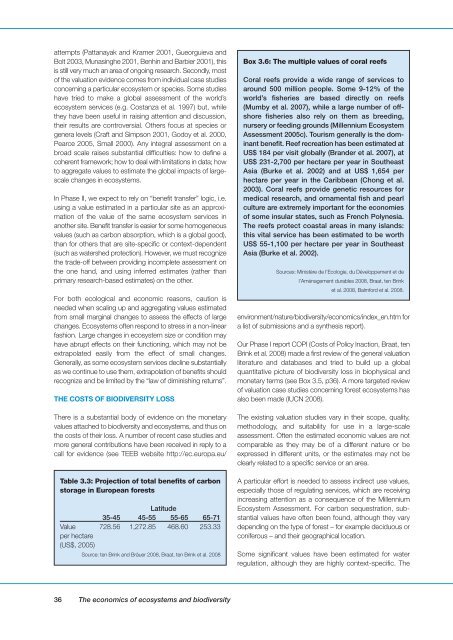Interim Report - TEEB
Interim Report - TEEB
Interim Report - TEEB
Create successful ePaper yourself
Turn your PDF publications into a flip-book with our unique Google optimized e-Paper software.
attempts (Pattanayak and Kramer 2001, Gueorguieva and<br />
Bolt 2003, Munasinghe 2001, Benhin and Barbier 2001), this<br />
is still very much an area of ongoing research. Secondly, most<br />
of the valuation evidence comes from individual case studies<br />
concerning a particular ecosystem or species. Some studies<br />
have tried to make a global assessment of the world’s<br />
ecosystem services (e.g. Costanza et al. 1997) but, while<br />
they have been useful in raising attention and discussion,<br />
their results are controversial. Others focus at species or<br />
genera levels (Craft and Simpson 2001, Godoy et al. 2000,<br />
Pearce 2005, Small 2000). Any integral assessment on a<br />
broad scale raises substantial difficulties: how to define a<br />
coherent framework; how to deal with limitations in data; how<br />
to aggregate values to estimate the global impacts of largescale<br />
changes in ecosystems.<br />
In Phase II, we expect to rely on “benefit transfer” logic, i.e.<br />
using a value estimated in a particular site as an approximation<br />
of the value of the same ecosystem services in<br />
another site. Benefit transfer is easier for some homogeneous<br />
values (such as carbon absorption, which is a global good),<br />
than for others that are site-specific or context-dependent<br />
(such as watershed protection). However, we must recognize<br />
the trade-off between providing incomplete assessment on<br />
the one hand, and using inferred estimates (rather than<br />
primary research-based estimates) on the other.<br />
For both ecological and economic reasons, caution is<br />
needed when scaling up and aggregating values estimated<br />
from small marginal changes to assess the effects of large<br />
changes. Ecosystems often respond to stress in a non-linear<br />
fashion. Large changes in ecosystem size or condition may<br />
have abrupt effects on their functioning, which may not be<br />
extrapolated easily from the effect of small changes.<br />
Generally, as some ecosystem services decline substantially<br />
as we continue to use them, extrapolation of benefits should<br />
recognize and be limited by the “law of diminishing returns”.<br />
THE COSTS OF BIODIVERSITY LOSS<br />
There is a substantial body of evidence on the monetary<br />
values attached to biodiversity and ecosystems, and thus on<br />
the costs of their loss. A number of recent case studies and<br />
more general contributions have been received in reply to a<br />
call for evidence (see <strong>TEEB</strong> website http://ec.europa.eu/<br />
Table 3.3: Projection of total benefits of carbon<br />
storage in European forests<br />
Latitude<br />
35-45 45-55 55-65 65-71<br />
Value 728.56 1,272.85 468.60 253.33<br />
per hectare<br />
(US$, 2005)<br />
Source: ten Brink and Bräuer 2008, Braat, ten Brink et al. 2008<br />
Box 3.6: The multiple values of coral reefs<br />
Coral reefs provide a wide range of services to<br />
around 500 million people. Some 9-12% of the<br />
world’s fisheries are based directly on reefs<br />
(Mumby et al. 2007), while a large number of offshore<br />
fisheries also rely on them as breeding,<br />
nursery or feeding grounds (Millennium Ecosystem<br />
Assessment 2005c). Tourism generally is the dominant<br />
benefit. Reef recreation has been estimated at<br />
US$ 184 per visit globally (Brander et al. 2007), at<br />
US$ 231-2,700 per hectare per year in Southeast<br />
Asia (Burke et al. 2002) and at US$ 1,654 per<br />
hectare per year in the Caribbean (Chong et al.<br />
2003). Coral reefs provide genetic resources for<br />
medical research, and ornamental fish and pearl<br />
culture are extremely important for the economies<br />
of some insular states, such as French Polynesia.<br />
The reefs protect coastal areas in many islands:<br />
this vital service has been estimated to be worth<br />
US$ 55-1,100 per hectare per year in Southeast<br />
Asia (Burke et al. 2002).<br />
Sources: Ministère de l’Ecologie, du Développement et de<br />
l’Aménagement durables 2008, Braat, ten Brink<br />
et al. 2008, Balmford et al. 2008.<br />
environment/nature/biodiversity/economics/index_en.htm for<br />
a list of submissions and a synthesis report).<br />
Our Phase I report COPI (Costs of Policy Inaction, Braat, ten<br />
Brink et al. 2008) made a first review of the general valuation<br />
literature and databases and tried to build up a global<br />
quantitative picture of biodiversity loss in biophysical and<br />
monetary terms (see Box 3.5, p36). A more targeted review<br />
of valuation case studies concerning forest ecosystems has<br />
also been made (IUCN 2008).<br />
The existing valuation studies vary in their scope, quality,<br />
methodology, and suitability for use in a large-scale<br />
assessment. Often the estimated economic values are not<br />
comparable as they may be of a different nature or be<br />
expressed in different units, or the estimates may not be<br />
clearly related to a specific service or an area.<br />
A particular effort is needed to assess indirect use values,<br />
especially those of regulating services, which are receiving<br />
increasing attention as a consequence of the Millennium<br />
Ecosystem Assessment. For carbon sequestration, substantial<br />
values have often been found, although they vary<br />
depending on the type of forest – for example deciduous or<br />
coniferous – and their geographical location.<br />
Some significant values have been estimated for water<br />
regulation, although they are highly context-specific. The<br />
36 The economics of ecosystems and biodiversity

















